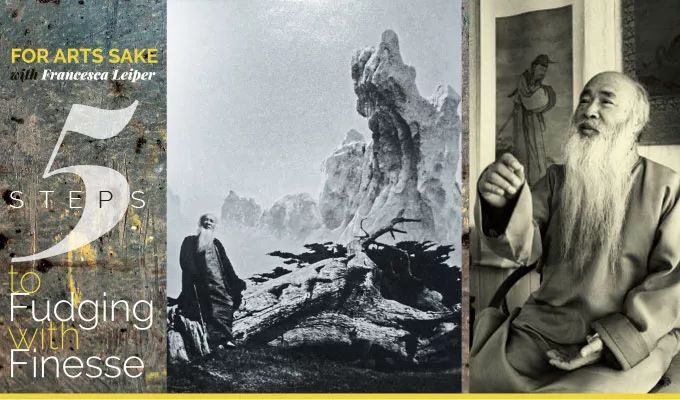“Dense Forrest and Layered Peaks” by Ju Ran, Tang Dynasty, British Museum. One of only two surviving works of the foremost landscape master. Fake.
“Riverbank” by Dong Yuan, Southern Tang, Metropolitan Museum of Art. “Art history would not have happened that way without this painting”. Also fake.
“Drinking and Singing at the Foot of a Precipitous Mountain” by Guan Tong, 10th century, Museum of Fine Arts Boston. Simply magnificent. Truly fake.
All three and many more were in fact the works of Zhang Daqian. Born into a lowly family in Sichuan in 1899, his exceptional talent and good helping of luck led him to become of the most renowned painters and master forgers of the 20th century, if not ever. So how did he do it?
Step 1: Skills
Zhang spend several years of his early career in the Mogao Caves of Dunhuang at the edge of the Silk Road, meticulously studying and copying wall paintings, sometimes for up to 14 hours in one day. The murals that he came to know by the back of his hand were exhibited around the world, propelling him into the public eye and equipping him with a repertoire of styles and modes across the history of Chinese painting.
But he was not only skilled at copying the work of others. He also developed a distinct style of his own that was deeply rooted in tradition yet immensely diverse, from the precise portraits to the abstract and expressive. He worked quickly and en masse. In 83 years of his long life, Zhang produced an average of 500 paintings per year.
Step 2: Stuff
One might think forgeries nowadays could never pass the scrupulous testing of modern technology, but we must not blindly believe science is the answer. Zhang was well versed in every asset of painting and fully aware of the importance of materials in making his finest forgeries. The crackled effect of aged silk was to convince its admirers without question, but later would be a trademark of his fakes.
Step 3: Facts
Any Chinese art historian will tell you of the importance of fact checking – finding records of paintings in ancient catalogues and historic texts to backup attribution. For Zhang this was the ready-made provenance. He knew the paintings that collectors yearned to find – the Ju Rans, Dong Yuans and Guan Tongs – of which few others existed, until…
Step 4: Audacity
In case you were wondering if Zhang had time for anything else in life, he was also a great socialiser, constantly travelling the world and surrounding himself with friends and family (allegedly, he had four wives and fathered as many as sixteen children). His innumerable “guanxi” helped him wriggle his paintings into world-renowned collections under the guise of ancient masters; while he himself was the guise of a traditional Chinese literati scholar, with his long cloak, wispy beard and pet gibbon.
Step 5: Grace
Perhaps a bit of ying and yang in life still played on Zhang’s conscience. Besides the reported 10 million dollars he made from his fakes to fuel an opulent lifestyle, he also donated several important works that have enriched collections of Chinese painting globally.
Zhang was an utter genius, whose outrageous behaviour and unmatched mastery won him the utmost respect in his field. His success as an artist has made him one of the most popular selling Chinese painters of his time and, ironically, the subject of today’s forgers. But what forger could ever fudge with the finesse of Zhang Daqian?









